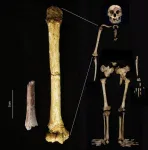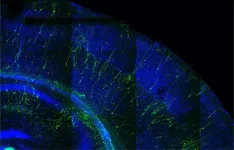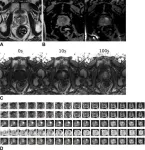(Press-News.org) A paper out today in Nature Communications reports the discovery of extremely rare early human fossils from the Indonesian island of Flores, including an astonishingly small adult limb bone.
Dated to about 700,000 years old, the new findings shed light on the evolution of Homo floresiensis, the so-called ‘Hobbits’ of Flores whose remains were uncovered in 2003 at Liang Bua cave in the island’s west by a team co-led by Australian-New Zealand archaeologist Professor Mike Morwood (1950–2013).
Archaeological evidence suggests these diminutive, small-brained humans inhabited Liang Bua as recently as 50,000 years ago, a time when our own species (Homo sapiens) was already long established in Australia to the south.
There has been much debate about the origin of the mysterious humans from Flores. It was first hypothesised that Homo floresiensis was a dwarfed descendant of early Asian Homo erectus.
Another theory is that the ‘Hobbit’ is a late-surviving remnant of a more ancient hominin from Africa that pre-dates Homo erectus and was small in stature to begin with, in which case possible candidates include Homo habilis or the famous ‘Lucy’ (Australopithecus afarensis).
Other than Liang Bua, hominin fossils have only ever been found at a single location on Flores: the open-air site of Mata Menge 75km to the east of the cave. Located in the sparsely populated tropical grasslands of the So’a Basin, this site has previously yielded several hominin fossils (a jaw fragment and six teeth) excavated from a layer of sandstone laid down by a small stream around 700,000 years ago.
Pre-dating the Liang Bua hominins by 650,000 years, the Mata Menge fossil remains have been shown to belong to at least three individuals with even slightly smaller jaws and teeth than Homo floresiensis, implying that small body size evolved early in the history of Flores hominins.
However, as postcranial elements (bones from below the head) had not been found in the fossil record at this site it could not be confirmed that these So’a Basin hominins were at least as small as, if not slightly smaller than, Homo floresiensis.
It was also unclear what species the Mata Menge fossils belonged to, owing to the lack of more diagnostic specimens. However, some teeth were deemed to be intermediate in form between those of early Asian Homo erectus and Homo floresiensis.
The new study published in Nature Communications was led by Professor Yousuke Kaifu of the University of Tokyo, Iwan Kurniawan of the Center for Geological Survey in Indonesia, and Associate Professor Gerrit van den Bergh from the University of Wollongong.
It reports the discovery of three additional hominin fossils from Mata Menge dating to 700,000 years ago, the outcome of several field seasons of excavations at this site. Most importantly, the new assemblage includes the first postcranial element, a distal shaft of an adult humerus (lower half of the upper arm bone).
The recovery of a fossil limb bone from the Mata Menge excavation site has been long-awaited because of the wealth of evidence it provides regarding the ancestral origin of Homo floresiensis.
Digital microscopy of the microstructure indicates that the small humerus is from an adult individual. Based on the estimated length of the bone, the team was able to calculate the body height of this hominin to be about 100cm tall. This is around 6cm shorter than the estimated body height of the 60,000-year-old Homo floresiensis skeleton from Liang Bua (~106cm, based on the femoral length).
“This 700,000-year-old adult humerus is not just shorter than that of Homo floresiensis, it is the smallest upper arm bone known from the hominin fossil record worldwide,” said Professor Adam Brumm from Griffith University’s Australian Research Centre for Human Evolution, a co-author of the paper.
“This very rare specimen confirms our hypothesis that the ancestors of Homo floresiensis were extremely small in body size; however, it is now apparent from the tiny proportions of this limb bone that the early progenitors of the ‘Hobbit’ were even smaller than we had previously thought.”
The two additional hominin teeth from Mata Menge are also small in size and one bears shape characteristics that are most consistent with early Homo erectus of Java. This similarity does not support the hypothesis that Homo floresiensis evolved from an earlier and more primitive type of hominin, the likes of which have never been recovered from Indonesia, or indeed the wider region outside Africa.
The Mata Menge human remains, which now total 10 fossil specimens, are from at least four individuals (including two children). All of them are very similar anatomically to the Liang Bua Homo floresiensis and can now be regarded as an older variant of this hominin. However, while a direct ancestor of the ‘Hobbit’, this earlier form had a less specialised dentition (more primitive teeth) than its descendant at Liang Bua.
Further, it is evident from the tiny arm bone that extreme body size reduction occurred early in the history of the Flores hominins.
“The evolutionary history of the Flores hominins is still largely unknown”, said Professor Brumm. “However, the new fossils strongly suggest that the ‘Hobbit’ story did indeed begin when a group of the early Asian hominins known as Homo erectus somehow became isolated on this remote Indonesian island, perhaps one million years ago, and underwent a dramatic body size reduction over time”.
The findings ‘Early evolution of extremely small body size in Homo floresiensis’ have been published in Nature Communications.
END
Smallest arm bone in human fossil record sheds light on the dawn of Homo floresiensis
2024-08-06
ELSE PRESS RELEASES FROM THIS DATE:
Type 2 diabetes and fracture risk in older women
2024-08-06
About The Study: The results from this study suggest that the higher fracture risk among older women with type 2 diabetes may be due to impaired physical function and not skeletal characteristics.
Corresponding Author: To contact the corresponding author, Mattias Lorentzon, MD, PhD, email mattias.lorentzon@medic.gu.se.
To access the embargoed study: Visit our For The Media website at this link https://media.jamanetwork.com/
(doi:10.1001/jamanetworkopen.2024.25106)
Editor’s Note: Please see the article for additional information, including other authors, author contributions and affiliations, conflict of interest and financial disclosures, and funding and ...
AI for early detection of pediatric eye diseases using mobile photos
2024-08-06
About The Study: In this cross-sectional study, the artificial intelligence (AI) model demonstrated strong performance in accurately identifying myopia, strabismus, and ptosis using only smartphone images. These results suggest that such a model could facilitate the early detection of pediatric eye diseases in a convenient manner at home.
Corresponding Authors: To contact the corresponding authors, email Lin Li, MD, PhD (jannetlee130@gmail.com), and Jie Xu, DHM (xujie@pjlab.org.cn).
To access the embargoed ...
Demographic representation of generative AI images of physicians
2024-08-06
About The Study: This study identifies demographic biases in artificial intelligence (AI)-generated images of physicians with disproportionate representation of white and male physicians and concerning underrepresentation of other races and ethnicities (Asian and Latino) and female physicians in some platforms. This bias has the potential to reinforce stereotypes and undermine diversity, equity, and inclusion initiatives within health care.
Corresponding Author: To contact the corresponding author, Sang Won Lee, MSc, email sangwon_lee@hms.harvard.edu.
To access the embargoed ...
When faster is not better: New study links premature development of human neurons to brain developmental disorders
2024-08-06
Leuven, 7 August 2024—The mechanisms underlying intellectual disabilities or autism remain largely unknown. Researchers in the labs of Prof. Pierre Vanderhaeghen and Prof. Vincent Bonin at the VIB-KU Leuven Center for Brain & Disease Research and NERF have discovered that mutations in a gene called SYNGAP1 disrupt the prolonged development of human neurons, which is thought to be essential for normal cognitive function. Their work has interesting implications for our understanding and treatment ...
Meteorin-like protein drains energy from T cells, limiting immune system’s power to fight cancer
2024-08-06
**EMBARGOED FOR RELEASE UNTIL AUG. 6 AT 11 A.M. ET**
A protein called Meteorin-like (METRNL) in the tumor microenvironment saps energy from T cells, thereby severely limiting their ability to fight cancer, according to new research directed by investigators at the Johns Hopkins University School of Medicine and the Johns Hopkins Kimmel Cancer Center and its Bloomberg~Kimmel Institute for Cancer Immunotherapy. Finding ways to block the effects of METRNL signaling on tumor-infiltrating T cells may allow these immune cells to regain the energy necessary to eliminate tumors.
A report about the work was published Aug. 6 in the journal Immunity.
METRNL ...
Live longer, die healthier
2024-08-06
Everyone wants to live to a ripe old age, but no one wants to be decrepit. Now, University of Connecticut researchers have demonstrated a treatment that could lengthen life—and vigor—up to the very end.
Even as human lifespans have lengthened over the past century, most people in old age suffer a serious health decline in the last decade of life. Chronic illnesses such as cancer, diabetes, or cardiovascular disease may begin, followed by frailty. Many interventions can prolong life, but not necessarily good health. And nobody wants to spend the last ...
Novel machine learning-based cluster analysis method that leverages target material property
2024-08-06
In materials science, substances are often classified based on defining factors such as their elemental composition or crystalline structure. This classification is crucial for advances in materials discovery, as it allows researchers to identify promising classes of materials and explore new ones with similar functions and properties. A recent Advanced Intelligent Systems study led by Researcher Nobuya Sato and Assistant Professor Akira Takahashi from Tokyo Institute of Technology developed a new machine learning-powered clustering technique. This technique groups similar materials by taking into account both their ...
CT health screening can identify diabetes risk
2024-08-06
OAK BROOK, Ill. – Analysis of CT scans in people who undergo imaging for health screening can identify individuals at risk of type 2 diabetes, according to a study published today in Radiology, a journal of the Radiological Society of North America (RSNA). Researchers said the findings underscore CT’s value in opportunistic imaging—the use of information from routine imaging examinations to learn more about a patient’s overall health.
For the new study, researchers evaluated the ability of automated CT-derived markers ...
AI model effective in detecting prostate cancer
2024-08-06
OAK BROOK, Ill. – A deep learning model performs at the level of an abdominal radiologist in the detection of clinically significant prostate cancer on MRI, according to a study published today in Radiology, a journal of the Radiological Society of North America (RSNA). The researchers hope the model can be used as an adjunct to radiologists to improve prostate cancer detection.
Prostate cancer is the second most common cancer in men worldwide. Radiologists typically use a technique that combines different MRI sequences (called multiparametric MRI) to diagnose clinically significant prostate cancer. ...
Exposure to wildfire smoke may affect patients undergoing surgery
2024-08-06
CHICAGO – Nearly 100 wildfires are currently raging throughout the country, burning more than 2 million acres. The rising frequency of these fires poses a special concern for anesthesiologists – the potential for increased rates of adverse outcomes from anesthesia and surgery among patients exposed to wildfire smoke, according to a special article in the Online First edition of Anesthesiology, the peer-reviewed journal of the American Society of Anesthesiologists (ASA).
"Wildfire smoke causes inflammation and is known to worsen heart and lung disease and pregnancy outcomes," said senior author Vijay Krishnamoorthy, M.D., M.P.H., Ph. D., chief of the Critical Care ...




